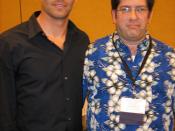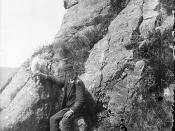Hotel Rwanda, directed by Terry George, is a 2004 film made depicting the Rwandan genocides. The historical context of the film is in 1994 in Rwanda, when the extremist Interahamwe militias were gathering forces to kill Tutsi tribe's people. They succeeded for the most part, killing more than 800,000 innocent people within a hundred days. The film is shown entirely from the point of view of Paul Rusesabagina, who hosted over 1200 Rwandan refugees in his Hotel Mille Collines.
The camera only leaves Paul's situation very rarely. The effect that this has on the veracity of the film is that it shows that this story is only his story. It recreates all the emotions of unpredictability, suspense and unsureness of what's going to happen next. For example, in one of the scenes after Paul and his family enjoy a safe night together, the next morning he wakes up with a gun to his head.
However, following Paul's situation is used more than just for dramatic value. The audience is drawn in to the film, as if they are right there with Paul, and this creates a very "real" experience.
United 93 uses second-skin camera placement to achieve effectively the same result. For example, during the hijacking, you would have all noticed the jerky motion of the camera and the "imperfect", out-of-focus shots. They illustrate the confusion in the atmosphere. Again the audience feels as if they are the person watching through the lens of the camera and that they are actually involved in the situation, thus recreating reality for the viewers.
In Hotel Rwanda, footage shot of the Interahamwe beating their victims is shown. It is footage that a news reporter catches on tape in the film, but is a replica of that which another man found...


![[Portrait of Les Paul, Fat Tuesday, New York, N.Y., ca. 1980s] (LOC)](https://s.writework.com/uploads/3/31608/portrait-les-paul-fat-tuesday-new-york-n-y-ca-1980s-loc-thumb.jpg)